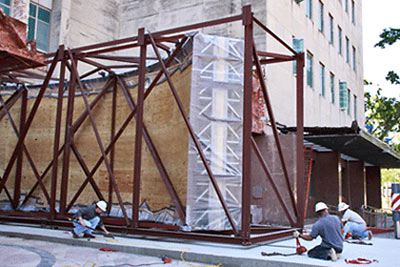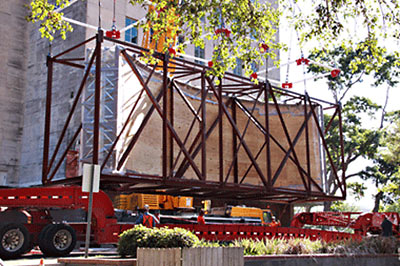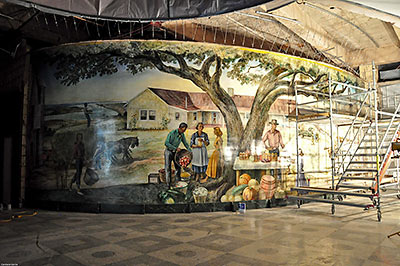
Last fall, the planned $500,000 rescue of a curved fresco painted by muralist Peter Hurd from the lobby of its Houston Main Building at 1100 Holcombe Blvd. was the focus of a small publicity campaign by UT’s M.D. Anderson Cancer Center. From the institution’s perspective it was probably a better story to focus attention on than the circumstances that instigated the move: the planned (and now active) demolition — despite the grumblings of many preservationists — of the 18-story 1952 Prudential Tower by Kenneth Franzheim that housed it. Since late January, when Linbeck (M.D. Anderson’s contractor) took the extraordinary step of firing fresco-conservation expert Nathan Zakheim from the job before the most delicate and proprietary portions of the process had been completed — and concerns were raised about how well the rescue could possibly be completed without him — the PR effort behind the tricky operation has been silent. Until today, that is.
***
A small feature story published in an internal M.D. Anderson newsletter — but apparently not available to the general public — announces that the Hurd mural of a West Texas farm scene has now left the building on a flatbed truck commandeered by Admiral Transfer and Rigging, and is on its way to a new home in a temporary storage facility in Midland, Texas, where it’s expected to arrive Friday evening. Moving the painting to the storage facility was part of the plan all along, but the article makes no mention of what had been earlier announced as the mural’s ultimate destination: a new public library in Artesia, New Mexico, close to some of Hurd’s other large-scale works.
Did the mural make it out in one piece? Will it stay intact for the carefully routed 840-mile, two-and-a-half-day journey? Will its condition be examined once it arrives, or will the assembly just sit there under covers for a couple of years until its new home is ready? The story doesn’t get into those kinds of details. But it does report that a photographer and videographer will be documenting the journey. And it describes the 3-hour process of getting the 58,000-lb. fresco-truss sandwich out the door of M.D. Anderson’s Houston Main Building, and onto the truck:


The mural, encased by a form-fitting plywood structure that was framed by a series of steel beams, made its grand exit with the assistance of ratcheted chains and skates—small, sturdy rectangular frames of steel surrounding a series of cylinders. The process was slow but necessary to ensure the mural’s stability and minimize stress.
Once it reached the end of the purpose-poured pad, a crane picked up the mural with a specially-constructed rigging framework and placed it onto a parametric frame trailer.
And, after the hours needed to assemble the crane and the rigging, it took just 10 minutes to pick the mural from its pad and place it on the trailer.
The front canopy of the building was demolished in January to allow the mural assembly a way to get out. If it doesn’t break into pieces on the journey, Hurd’s 16-ft.-by-46-ft. mural will go in the record books as the largest fresco painting ever moved successfully.

- Previously on Swamplot: Will M.D. Anderson’s Contractor Bungle the Largest Fresco Rescue Ever?, Sure Looks Like Demolition This Time: M.D. Anderson Begins Taking Down the Prudential Tower, The Prudential Tower’s Grand Entrance, Before Its Not-so-Grand Exit, Update: M.D. Anderson Not Demolishing Former Prudential Tower Yet, Just Hacking Away at It a Bit, Report: M.D. Anderson Begins Demolishing Med Center Icon
Photos: Candace Garcia (mural); M.D. Anderson (all others)





Sad that it couldn’t remain in Houston. I wonder if the right wing doctor trustees thought that the subject matter was too lefty, too WPA for their institution.
Why don’t you guys get a life? It was preserved. What else do you want other than your unrealistic dribble. Give Anderson some credit for finding a suitable home for the mural.
If only the public knew the whole store. The best was taken in by MDACC and the new owner. I guess some people just want to speak with out really knowing the truth and yes do not listen to the news. They only state what they want you to hear so that they can sit in the back of the class room and watch others make a fool out of them self.
Yup, the mural was commissioned by Those Commies at Prudential Insurance. The building was impressive from the outside but not functional inside. No great loss.
The mural wasn’t Great Art but a piece of history that has to gone a place it can be appreciated. A greater loss was the Tamayo mural cut out of the former Bank of the Southwest building downtown–just because it didn’t fit the new remodeling scheme. (A collector bought it & allowed it to be displayed in Dallas; then it was sold again by Sotheby’s.)
The stories about the dismanteling of the Prudential Building (as it will always be known to me) and the beautiful fresco make me sad. I worked for Prudential in the 1960’s and 1970’s. I have wonderful memories of that building.Back then our lunches were provided free (imagine that!).We could sit around the pool on our lunch hour or swim or play tennis. I just remember how beautiful the lobby was with all that granite and marble. It was a fun place to work….Periodically they would come on the PA system and have giveaways to different ball games, turkeys at Thanksgiving, etc. We had a ballroom where they had dances and parties several times a year. Goodbye old “PRU”………
@ merry,
wow, that really does sound like the good ol’ days!
I passed this mural every day when I worked for Prudential Insurance Company beginning in 1969 and again when I worked in the Medical Center from 1979 through 2004. The mural is beautiful and timeless and I enjoyed passing it when I had business in the UT Houston Main Building. I hope that it can stay in Texas to remind us ALL of our heritage.
I am happy to report that the lovely (and loved) mural made it’s way safely and exuberantly to it’s new home yesterday inside the (not yet completed) Artesia Public Library! It was amid great fanfare that the beautiful piece of art was transported into town and after several hours, was lowered by crane into it’s permanent home. This town could not be prouder and more appreciative to the generous citizens who made this possible!
Artesia is a great little town and the people there will appreciate it! I am glad it is there, and next time I am in Artesia, I will be sure to take a look.